Aquarium stones: types, selection and application

A good aquarium should look as natural and believable as possible, which is why many aquarists tend to visually bring it closer to the river or seabed. It is impossible to do this without stones, and although you can buy both replicas and real cobblestones at the pet store, many experienced fish breeders prefer to personally select pebbles from natural bodies of water. However, as in all other cases, this must be done wisely.

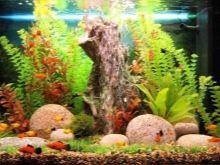
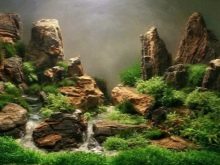
What are they for?
Stones for an aquarium are perceived only by beginners purely as an aesthetic decoration, in fact, their functionality is much wider and that is why you cannot choose any minerals for your home reservoir. In addition to the banal beauty, such aquarium decorations are also needed to achieve the following goals:
- imitation of a natural habitat - for a fish a simple vessel will be as comfortable as an unfurnished apartment for you, and pets will take root much better if the interior of the aquarium resembles the places in which they live in the wild;
- you can hide in the stones - even if you are sure that your favorite fish in the aquarium does not have any enemies, this will not help her to abandon her instincts, and if she does not have the opportunity to hide, she will be nervous;
- pebbles can be used to equip a nest - another instinct makes the fish hide their clutch in order to be sure that predators will not get to it, it will not be blown away by the current, and so on;
- Depending on their chemical composition, natural stones can also affect the hardness level of the aquarium water.

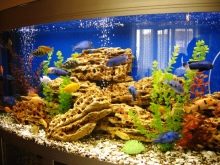
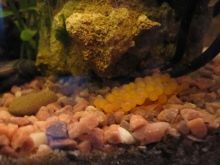
Artificial stones can be used too - it's not for nothing that they are sold in pet stores, where all the goods are selected by specialists. They are good in that they do not require any preliminary preparation, but one should not overdo it with their originality - they do not always resemble what can actually be found at the bottom of water bodies.
There are also natural stones on sale that have already been processed - they are disinfected, possibly tinted or even assembled into integral compositions.
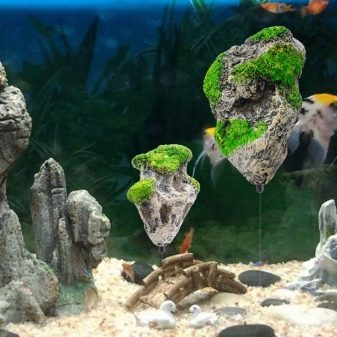
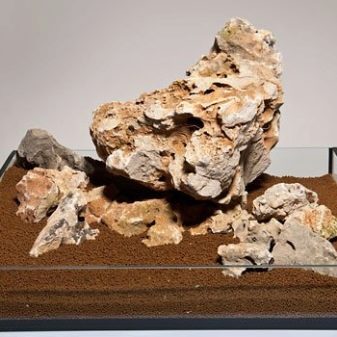
What stones can I use?
First of all, you can use any artificial decorative stones that are sold in stores. Colored glass or even a luminous placer will decorate the aquarium bottom and add interesting overflows to it, while it will not affect the chemical composition of the water. Decorative products that received their own well-established names, for example, "The Dragon".
Choosing natural stones, it should be understood that not all minerals are suitable for such a purpose. By the way, it is not even desirable to collect material everywhere - sea stones are not in great demand among experienced aquarists, they prefer to collect granite fragments in the vicinity of stone quarries, the raw materials of which are then sent to construction sites or for sculptural needs. Naturally, even here, not absolutely everything is suitable for adding to the aquarium.
To make sure that the new decoration does not change the chemical composition of the water, it is enough to drop a drop of vinegar on the pebble - the reaction that has begun shows that potentially excess substances will be released into the water. True, for the same cichlids, this would only be useful, but a beginner still should not experiment with this.
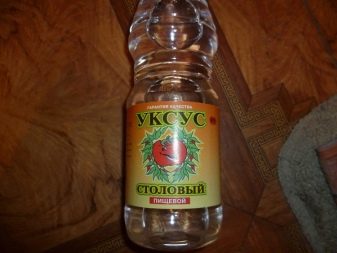
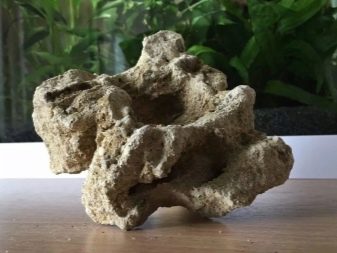
Experienced aquarists advise younger colleagues to give preference to quartz - it is easy to recognize by its characteristic veins or crystals of a whitish and transparent structure. In addition, for the sake of aesthetics of the aquarium and the safety of its inhabitants, it is advised to pay special attention to ensuring that the stones are of the same breed, have the same size and texture, and also do not have sharp edges that can be injured.
If we talk about the specific names of the breeds, then there will be many options. Of what is often found in pet stores, you should pay attention to the so-called Kenyan stone and Carpathian sandstone. Will not be superfluous either gneiss and granite, limestone and shale, tuff and porphyry, marble and quartzite, and if you find, then lava.
For those who are not chasing unique designs and simply want a piece of the sea, pebbles and shell rock are, of course, a common choice.
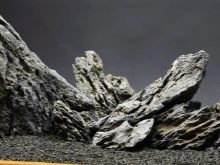

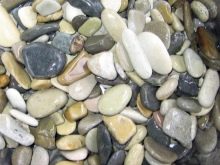
Harmful breeds
Geologists could focus on professional rock names, but for a beginner it is usually just a bunch of obscure names and nothing more. We will briefly describe which add-ons are not suitable for placement in the aquarium and why.
- Stones found near mines for the extraction of any ore are not suitable. Even a small admixture of these minerals can be harmful to pets.
- Radiation and pesticides are also detrimental to the health of the aquarium dwellers. You are unlikely to go to the zone of radiation contamination, but you should not collect material in the vicinity of fields either.
- Any strong odor indicates that the stone is emitting volatiles.... Without understanding, you cannot be sure that this is good for the fish.
- The copy must not include obvious metal streaks or rust. Metals are generally undesirable for fish, especially when it comes to iron and heavy metals. For the same reason, chunks of ore should never be used, because you will face the extinction of pets, which is difficult to explain otherwise.
- The bright color of the stone usually indicates that that it contains some relatively rare chemical elements.Again, don't experiment without knowing how it will affect the ecosystem.
- Pebbles that are soft and easily crumbly are likely to be of calcareous origin. Such a mineral has a large amount of calcium and dissolves easily, and therefore will inevitably lead to a bias in the acidity and hardness of the aquarium moisture. The only exception to the rule is lime tuff, which is acceptable in aquariums where alkaline water is used.
- Large pebbles are not welcome, especially if its surface cannot be called uniform and smooth - these are ideal circumstances for the fish to get hurt or even get stuck. For the same reason, it is undesirable to use cobblestones that are too large and heavy.
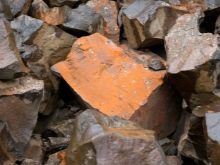
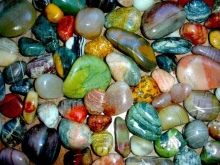

How to choose?
The basic principles for the selection of rocks and minerals have already been described above, therefore it remains to consider those aspects that have not yet been touched upon by our attention. The choice of stones is a difficult task and from the above, we understood which ones can and cannot be chosen, but did not figure out exactly how to do it.
Even choosing beautiful stones that fit the above requests in all respects, you will not be able to adequately design a pond the first time. Experienced aquarists advise to begin with a clear idea of the end result you would like to get, and only then start collecting or purchasing material.
A feverish selection of all the interesting things that lie on the road will not help create an attractive design - it will turn out brightly, but at random and tasteless.
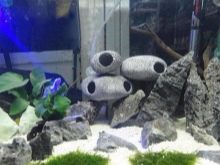
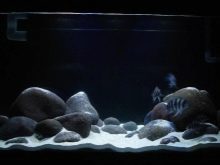
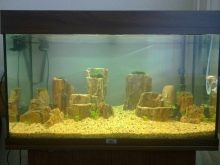
If you are collecting minerals yourself, never rely on the samples that are best for you. Practice shows that stones are always needed more than it seemed at first - some simply do not fit in shape and do not "fall into place", and therefore need to be replaced by smaller ones.
Agree, it will not work very well if you brought natural "decorations" from distant seas and you simply have nothing to replace an unsuitable specimen, and without it the whole concept of the composition is destroyed. For this reason, the stones are divided into "suitable" and "unsuitable" already directly above the aquarium.
How to prepare?
Shop stones attract many novice aquarists because they do not need to invent anything with them - they are initially selected so as not to harm the fish, they are probably already processed and can be used immediately. In addition, they often have already made up pretty creative compositions, thanks to which your aquarium may not be original, but it will definitely turn out to be beautiful.
However, there is a category of people who do not understand how you can pay for what is literally lying under your feet. As we already understood, collecting stones on your own is not prohibited, but you cannot just collect stones on the street and lower them into the water - by doing this, you risk introducing many different infections into the ecosystem, from which it will be very difficult to get rid of it later.
To prevent this from happening, you need to know how to properly handle the collected material. Let us remind you, just in case, that only certain types of minerals are suitable for immersion; a preliminary test with a drop of vinegar is also desirable. But even if the specimen has passed this selection, it is still not ready.
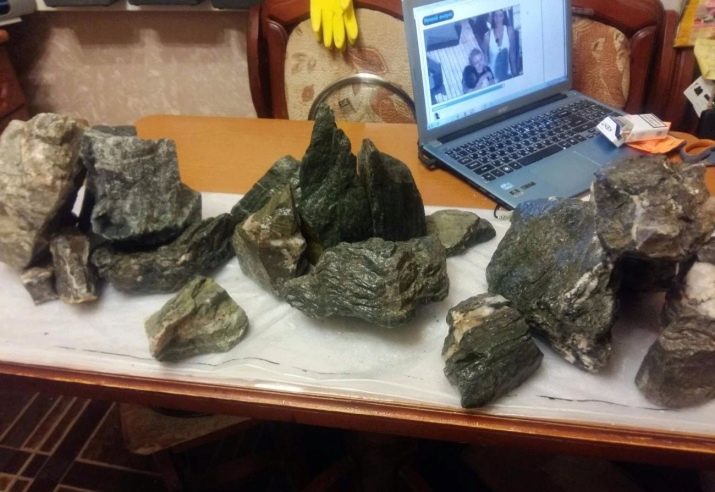
Before moving to the aquarium, it must go through the following procedures.
- The washing up. It is carried out only under running water of good pressure, capable of effectively washing away dirt and even harmful microorganisms. Do not overdo it - only water is used for washing, but soap and detergents are unacceptable, since you cannot know what chemical reactions will provoke their interaction with the breed.
- Cleaning. Even a powerful jet of water does not completely remove all the dirt, therefore the aquarist-decorator should arm himself with a brush and thoroughly walk over the entire surface, including crevices.Not only dirt, but also any plaque, remnants of lichens and mosses, and even more so insects - all this must be removed.
- Boiling. This is where opinions differ - some say that it is necessary to boil over low heat for 3 hours, for others 20 minutes or even roasting in the oven for the same time is enough. There is also another alternative in the form of drying in the fresh air for 14-15 days, but this method raises certain doubts.
- Cooling down. If you still prefer any kind of heat treatment as faster and more efficient, do not rush to throw the red-hot mineral into the water. It is advisable to bring it to the temperature that is typical for the water in the aquarium, so as not to cause a sharp temperature drop in the ecosystem.
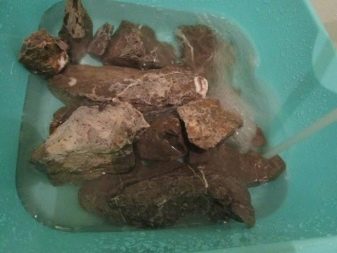

Design options
Even the most diligent beginner hardly knows how to decorate an aquarium with his own hands so that the design comes out beautiful, unobtrusive and stylistically correct. You don't have to come up with unique compositions from scratch - you can make decoration in one of the styles popular nowadays, using vivid examples of ready-made aquariums.
- Dutch style - this is a full-fledged flowerbed with plants, only located under water. There are always a lot of green spaces in such an aquarium, but they are strictly sorted by height, color and size, do not climb into "someone else's" territory and completely occupy "their own". In this case, it is worth putting pebbles and shell rock as an imitation of paths between flower beds.
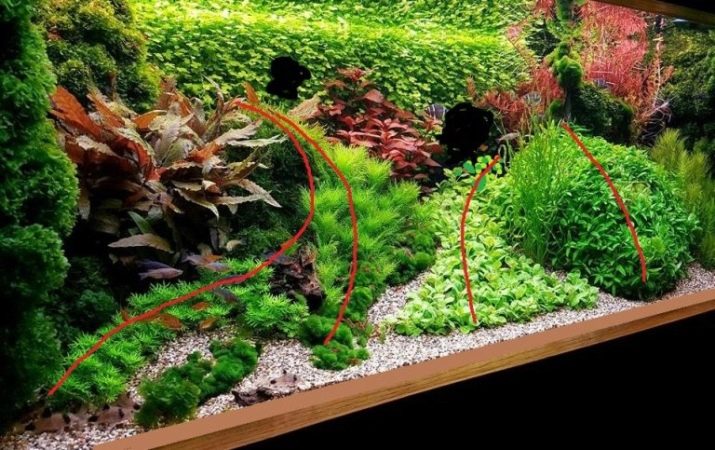
- Japanese style also imitates terrestrial landscapes, but of a completely different kind. Here the stones are not used as a substrate, but as an ivagumi, a typical composition of Japanese rock gardens.
Excessive decorations are inappropriate here, minimalism in design is encouraged, however, the cobblestones themselves are selected in different sizes to achieve picturesqueness and aesthetic appeal.
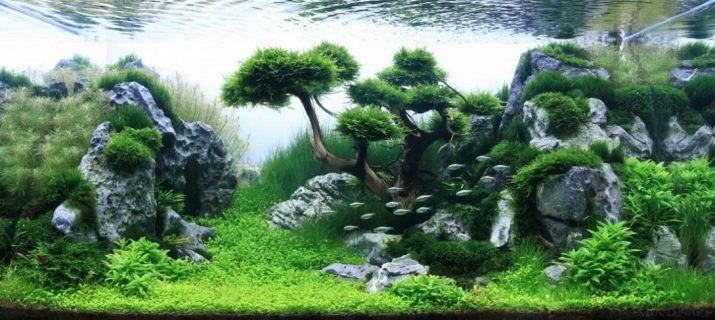
- Pseudo-natural style - the very thing for everyone who is not ready to spend money on registration and bother too much with it. This version of the aquarium requires a minimum of effort and money, and therefore looks quite simple, but the same pebbles and shell rock, as well as granite, will be quite appropriate here.
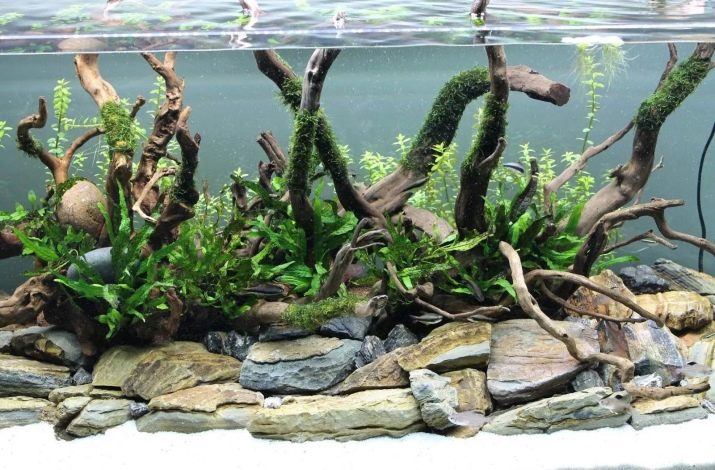
- Natural style rightly considered one of the most difficult in terms of reproduction, only the most avid aquarists resort to it, and even then not all. The meaning of this approach is to recreate the design of a certain section of the bottom of the reservoir with maximum (sometimes - literally photographic!) Accuracy. An imitation of a specific body of water, such as Lake Malawi, is often done.
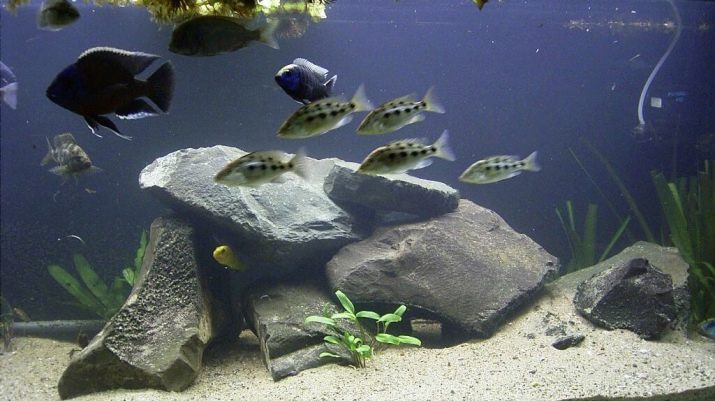
Possible problems
One of the typical problems that occurs after the aquarium has been decorated with stones is trauma to the fish from sharp edges or from getting stuck in gaps between large minerals. Such consequences are especially likely if you breed active animals that like to swim at high speeds.
You must understand that if something like this has already happened once, then in the future the situation will most likely repeat itself. If you value the life and health of your pets, you may have to sacrifice the created design, reworking it towards less injury risk or fundamentally changing it.
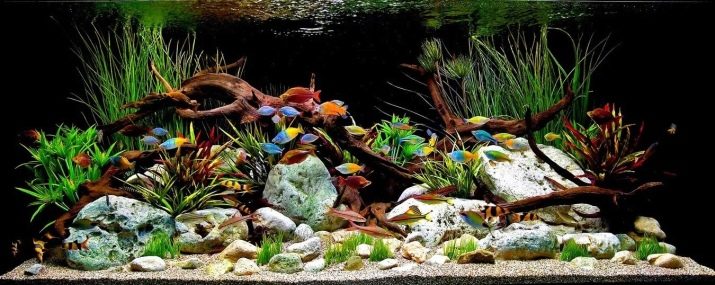
Another moment, which often does not cause a proper timely response from beginners, is the appearance of a plaque on the stones, which was not there at the time of the dive. The color of the lesions is usually black, green, or whitish, although in theory it can be almost anything. Its appearance indicates that algae have grown in your artificial reservoir, which in the overwhelming majority of cases are considered weeds and interfere with the normal development of other species.
In general, the presence of algae is not considered critical: most likely, they will inevitably be present in small quantities, but if there is a sharp, burst-like increase in the number of weeds, this indicates serious problems in the organization of the ecosystem.

The reasons for the appearance of plaque include too dirty water, which is due to rare changes or overcrowding of the aquarium, insufficient or excessive illumination, excess or lack of fertilizer, as well as inadequately high temperatures. Plaque is removed by cleaning or replacing natural enemies of algae, and so that the situation does not repeat itself, it is necessary to even out the biobalance and create normal conditions under which the weeds will not have a chance.
In critical situations, you will have to go to the pet store for special products, which, being potentially dangerous for fish, remain the last way to solve the problem.
The video below will tell you how to choose stones for an aquarium.








